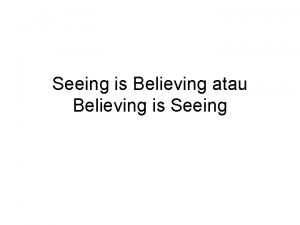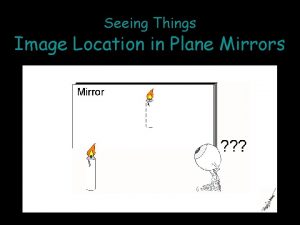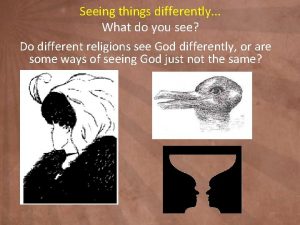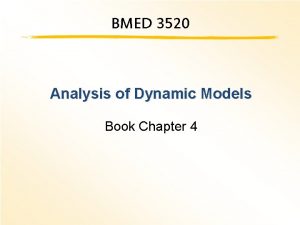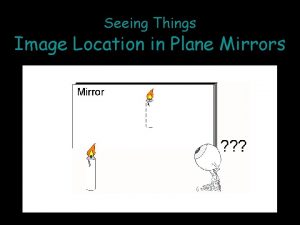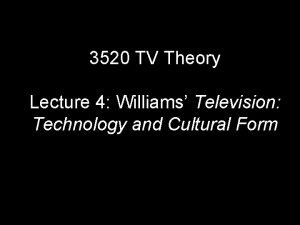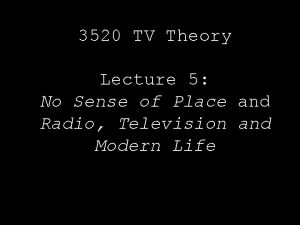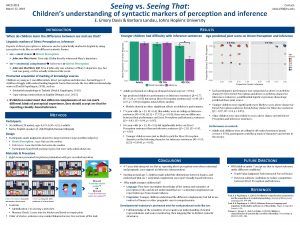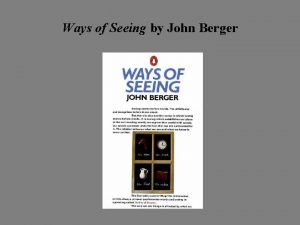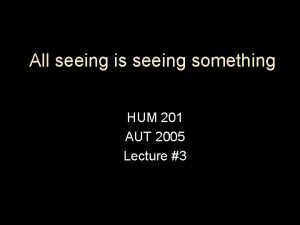3520 TV Theory Lecture 6 Seeing Things and










- Slides: 10

3520 TV Theory Lecture 6: Seeing Things and Televisuality

Ellis’ key concept: witnessing Witnessing: “we cannot say that we do not know” Accessibility of the world through media produces a mixture of knowledge and separation that breeds guilt, disinterest but also feelings of complicity Key condition: the media-saturated society TV: maximises witness by making it live

Historical phases of the TV/consumer society relation: scarcity From the 1920 s: modern domestic consumer economy Premises: (Fordist) mass production, mass middle class affluency The single-channel society: a common public and private life Heyday of public service broadcasting

Ellis’ phase II: availability Scarcity reduced by commercial competition: USA from the outset, Britain from the 1950 s, Norway from the 1980 s Technology tendencies: several TVs, the remote, video Consumer tendencies: further affluence, move toward subcultural/sectional interests, marking difference Production tendencies: differentiation, flexibilisation

Key concept: working through Ideal situation: a viewer uses multi-channel television to come to terms with the uncertainties and frustrations of witnessing Working through “… renders familiar, integrates and provides a place for the difficult material that it brings to our witness. It exhausts an area of concern …” (p. 79) Borrowed from psychoanalysis: the stage of coming to terms with what the unconscious reveals

Caldwell: Televisuality: a catch-all term for a set of aesthetic, production and organisation tendencies Wider framework: the crisis of the American networks from the 1980 s: Fox, cable Organisation strategies: audience targeting: 20 -40 group, upmarket moves, recycling Production: Introduction of digital technology in production (e. g video assist) and postproduction (e. g effects suites)

Aesthetics of televisuality The videographic The painterly The plastic The transparent Intermedia The cinematic Highlighted milieus Narrative expansion & complexity Event-status programming Authorialism

Caldwell’s critiques Critique of the “glance theory” (Ellis’ “Visible Fictions”) Critique of the ideology of liveness (e. g Scannell) Critique of the high theory/low culture divide (e. g. critical theory)

Ellis’ phase III: Plenty Digitalisation of distribution does away with the scarcity argument around frequencies and allows for plentiful channel output Introduces new modes of distribution: digital TV, web TV, TIVO Introduces new modes of interacting: buying programming and consumer goods, “coproducing” programmes, participating in programmes The logic of channel and program loyalty is tendentially replaced by brand loyalty

Critique of the interactive choice ideal Industry discourse involves a promise of viewer empowerment, through choice and through interactive added services that turn the consumer into an active user Ellis: “Time famine”, “choice fatigue” Caldwell: demand-led development, ideology of choice, “interactive pizza”
 Seeing is believing atau believing is seeing
Seeing is believing atau believing is seeing Location of plane mirror
Location of plane mirror Seeing things differently images
Seeing things differently images Extrator primario colhedora cana
Extrator primario colhedora cana Bmed 3520
Bmed 3520 Elevador colhedora de cana
Elevador colhedora de cana Circuito hidráulico john deere
Circuito hidráulico john deere Colhedora de cana john deere 3520
Colhedora de cana john deere 3520 Colhedora de cana john deere 3520 manutenção
Colhedora de cana john deere 3520 manutenção Colhedora john deere 3520
Colhedora john deere 3520 Códigos de falha da colhedora 3520
Códigos de falha da colhedora 3520
